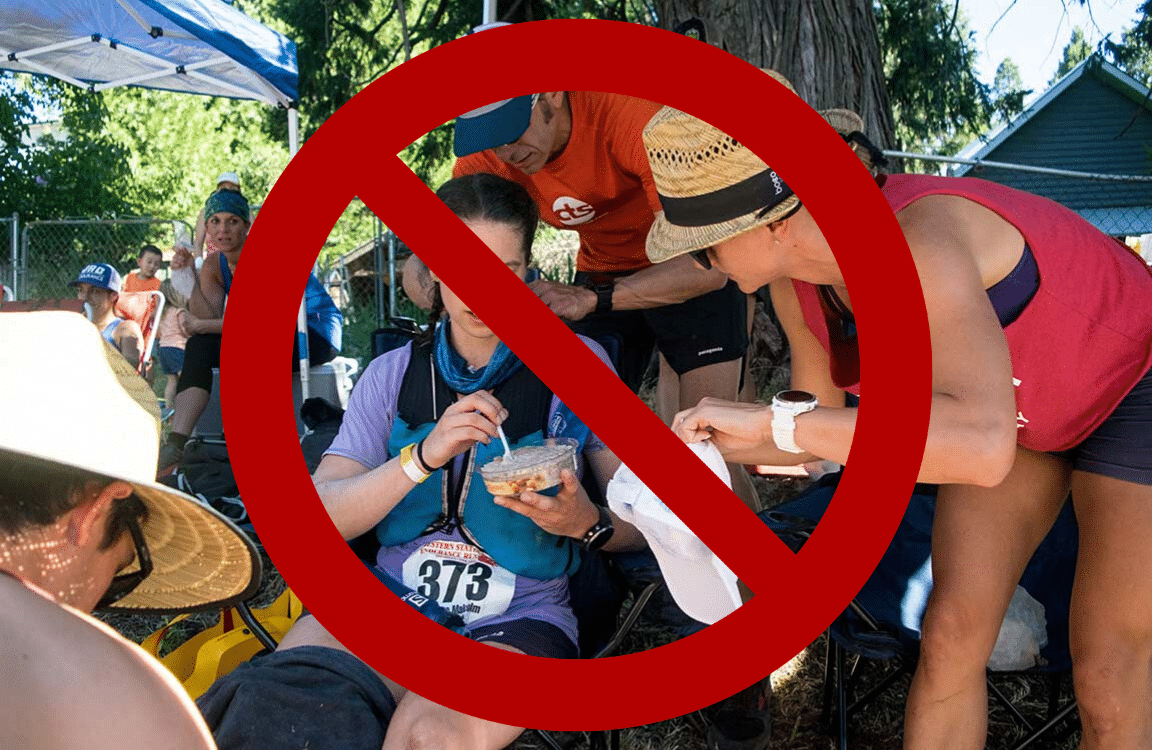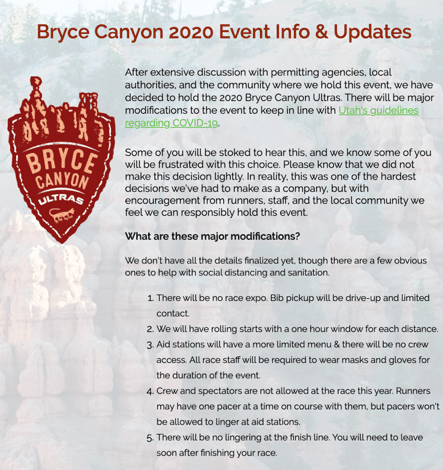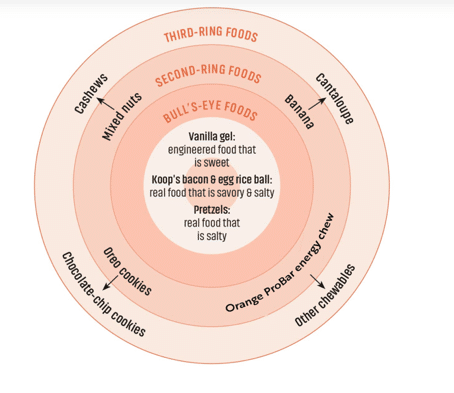
Training to Race by New COVID-Era Ultramarathon Rules
By Jason Koop,
Head Coach of CTS Ultrarunning
In-person racing will undoubtedly look different when it returns, whether it’s in 2020 or 2021. Physical distancing norms, crowd size limits and sanitization procedures are going to give race directors a few grey hairs, and they will impact runners as well. Simple things like pre-race briefings and check-in will likely have virtual components. Crew access could be limited or staggered to reduce crowds. Wave starts commonly seen in major marathons will likely make their way to trail races to reduce contact between participants. Aid stations might have simpler menus in an effort to streamline and potentially compensate for a dearth of volunteers. Already, we are seeing COVID-related changes unfold with races like the Bryce Canyon Ultras, which is scheduled to take place at the end of May, as well as guidance issued by USA Triathlon. I encourage ultrarunners to pay attention to these early movers’ operations to get a better sense for what they might encounter when your long awaited race returns.
Although each race will have its own unique set of rules, these new norms will have practical training implications for ultrarunners. Athletes hoping for a win or to finish under the cutoffs will be similarly affected. Regardless of your goals for your upcoming race, here are some things to bear in mind during the training process.
Challenge: Crews and pacers will be limited
Pacers have become a lifeline for physically and mentally struggling athletes during the later miles of a race. Pacers also serve as a safety net in event of a medical emergency or on the occasion that a runner becomes lost. Similarly, personal crews have become staples at aid stations. Their ability to deliver homemade concoctions, like a bowl of mashed potatoes with just the right amount of salt, have been called everything from lifesaving to mind altering. Crews also provide valuable emotional and medical support. The latter can range from simply patching a blister to reinserting and bracing a separated shoulder, as we saw in Killian Jornet’s 2017 Hardrock win. These luxuries in the post COVID world are likely to be just that, luxuries. Ultrarunners should fully expect less frequent access to pacers and crew for ultramarathons moving forward.
Planning for the possibility of pacer-less and crew-less races is going to put more emphasis on the runner’s self-reliance. Without a crew or pacers (or at least less access to them), troubleshooting a sour stomach or flagging motivation are going to be the runner’s responsibility alone. Here are two ways you can leverage day to day training to better prepare for these types of scenarios.

Figure 1-Crew and pacer limitations for the Bryce Canyon Ultramarathons
Solution: Mental rehearsals
Before you go out on your next run, conjure up the worst situation you can realistically imagine being in during your next ultramarathon. This could be running out of food in the middle of the night, suffering from a bonk and having your headlamp die all at the same time. Or it might be a massive cramp that just won’t shake, leaving you hobbled on the side of the trail. In any case, come up with your own personal worst-case scenario. You can dream it up in your head or write it down in a notebook, whatever helps you process the situation.
Then, during your run, rehearse what you would do if you actually found yourself in that situation. Visualize what you would do, how you would feel and what concrete steps you would take to pull yourself out of the theoretical hole. Chances are, you will find a solution. You can rinse and repeat this exercise with any number of worst case-type scenarios. Sure, the exact situation you encounter during a race is unlikely to be precisely the same as the one you rehearsed in training. But, having a framework to solve any problem is invaluable, as is the confidence that comes with knowing you can rely on your own wherewithal.
All too often, we use our crews and pacers as safety net should things go wrong. We neglect the mental training we should do because we feel our friends and family acting as crew will provide a stopgap for the deficiency if warranted. These band-aid approaches are a flimsy excuse for the real thing: relying on your own means should things go south.
Challenge: Aid stations will have pared down menus
At one point or another, most ultrarunners have had their race saved by some unheralded aid station volunteer who magically conjured up a perfect potion of fat, sugar and salt that raised them from their grave. Maybe that concoction was a cheese and bacon quesadilla or an over-salted helping of tater tots, but in any case, the magic elixir wasn’t part of the nutrition plan. At last year’s Tor Des Géants, I was propelled out of a particularly low point by a contrived creation of polenta, chicken stock, and salt and vinegar potato chips, none of which was remotely on my fueling radar at the time. These random race-saving foodstuffs will likely be more difficult to come by as aid stations figure out how to manage the confluence of increased sanitization procedures, decreased volunteer manpower and diminished ability to pull the caloric rabbit out of the magic hat.
As with the reduced dependence on pacers and crews, runners are going to have to increasingly rely on themselves for nutritional support. This means deliberately developing a rotation of liquids, solids, gels, real foods and engineered sports foods they can rely on during the race. In order to develop this personal menu, I have my athletes go through an ‘inside-out’ approach called the Bullseye Nutrition Strategy.
► Free Ultrarunning Training Assessment Quiz
Take our free 2-minute quiz to discover how effective your training is and get recommendations for how you can improve.

Solution: The Bullseye Nutrition Strategy
During training, particularly during the longer runs, I have athletes experiment with different—and sometimes counterintuitive—foods to help them reach their target calorie ranges. Foods that work are easy to open and eat on the run. They taste good, don’t get stuck in your teeth, and make you run as well as or better than you were running before eating them. Foods that don’t work are difficult to open, messy, crumbly, and hard to hold in one hand. They get stuck in your mouth, are too dry, or are tough to swallow without choking. Most of all, they sit in your gut like a calorie bomb, make you feel bloated or full, and slow you down. Your goal is to find three to five foods you can count on to work in any situation. These are your bull’s-eye foods.
All the food options you try can be categorized by where they fall on a target. Your bull’s-eye foods are your tried-and-true favorites. If these core foods begin to fail, because you’re tired of eating them, craving more sweetness or saltiness, or craving a different texture, then you can choose foods from the next ring of the target. These are foods you may not eat all the time, but you have tried them in training and know they work for you.
Beyond this ring are foods that you haven’t tried but that are similar to foods you have tried. For instance, you may know that Oreos work for you, so it’s easy to extrapolate and try a chocolate chip cookie or oatmeal cream pie (one of our camp favorites) in training.
Enjoying This Article? Get More Free Running Training Tips
Get our coaches' best training advice, delivered straight to your inbox weekly.
Anything beyond this ring is off target altogether. These are the foods you know don’t work for you and foods similar to foods that don’t work for you. It is important to list these foods out, as well, so you are reminded of the things you have tried that have not worked in training.
Developing your bull’s-eye foods
Variety is important in your short list of bull’s-eye foods. The end goal is to find a combination of three to five foods that, together, meet all the following criteria:
- At least one engineered food (gel, chewable, or calorie-rich drink)
- At least one real food—something you make or assemble or that is not made specifically for running (rice ball, peanut butter and jelly sandwich, or pretzels)
- Something sweet
- Something salty
- Something savory
If you construct this combination correctly, these bull’s-eye foods can be rotated and substituted during any race as needed, according to your target calorie range. After these core foods have been fully vetted, experiment with backup (second-ring) foods. These backup foodstuffs are what you can confidently fall back on when you lose your taste or craving for your bull’s-eye foods. Third ring foods are a final derivative and can be utilized when all else fails. I have included an actual example of a ultrarunner’s bull-eye’s strategy in the figure below.
Take home
Ultrarunning races are going to continue. If anything, they will be some of the first mass participation events back on the scene. Ultramarathons have relatively low participant density and an accommodating infrastructure well suited to our post COVID-19 world. When the races do come back, be prepared for them. They are likely to change, and I think some of those changes will be for the better in terms of athlete preparedness.


Comments 8
Pingback: Trail Running Daily News | Wednesday, May 20 - Yeovil Marathon
All races I do I personally run self sufficient and use aid stations as a treat and to top up water.
By the way, any ETA on your book’s 2nd edition ? I remember you mentioned that in one of your recent Koopcast 😉
“Crews and pacers will be limited”
That’s one thing I am happy about. When I see some runners that have a Formula 1 staff behind them and sometimes that benefit from illegal muling, I can only be happy about this forced change as I feel like it has changed our sport to a different “vibe”
Today, I received an email from J. Varner (Rainshadow running) stating this :
“Going forward we will be operating races on a much smaller scale(meaning less runners per race/day) and in a more “bare bones”, “old-school” manner that will put more of the onus on the runner to be self sufficient”
I want more bare bones races !
Pingback: Trail Running Daily News | Wednesday, May 20 | Ultrarunnerpodcast.com
You lost me @ “Aid stations will have pared down menus”…
Thanks for sharing, Koop! I appreciate your expertise and content. Keep hammering!
Thanks Koop. I am watching the Bryce Canyon race closely.
Thinking of future races, I tested that scenario yesterday (minimal aid) with a 18 mile, 4 hour, hilly run. Stashed a quart of water. Carried 2L (2 quart) and 1000 calories (planned to consume 600). It felt pretty empowering.